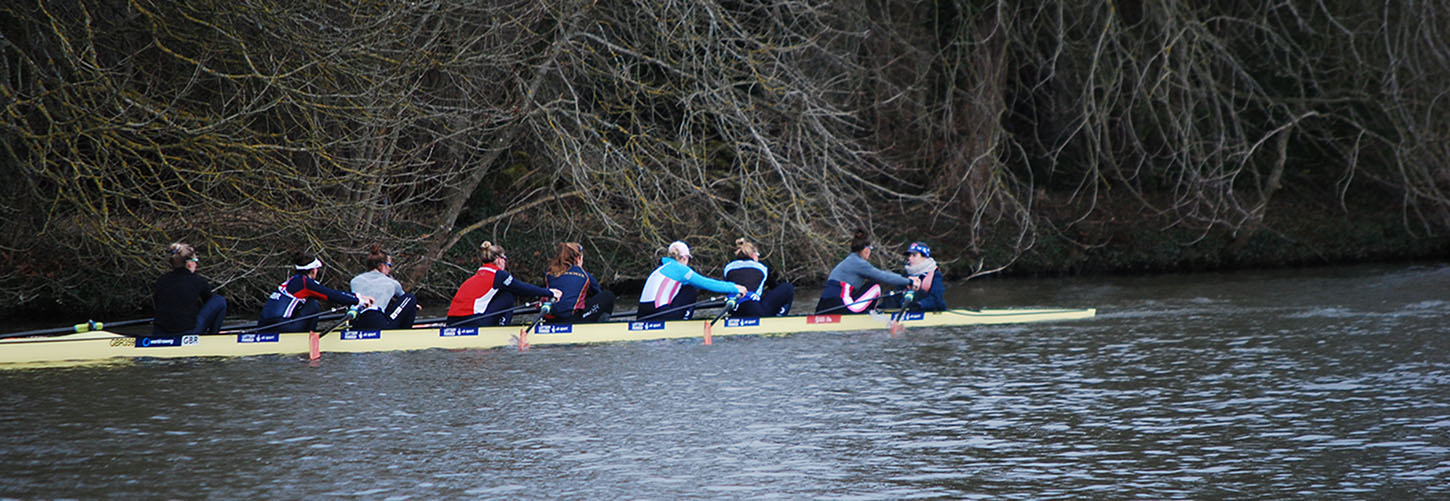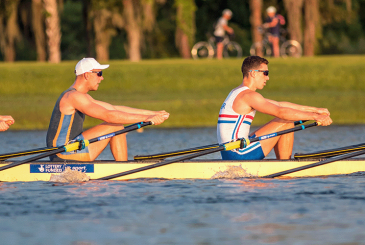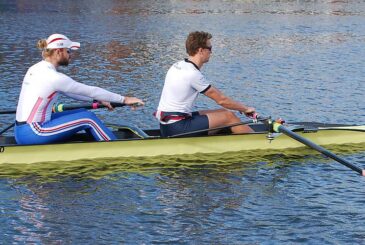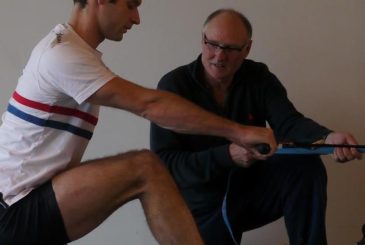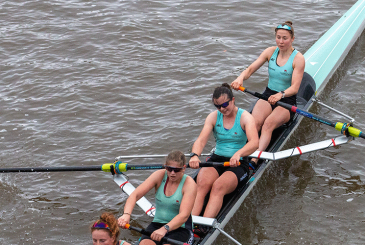Coach consultant Robin Williams explains why there’s a lot more to timing than meets the eye
Timing and time can be looked at in two ways, the obvious and visible external sense, versus the hidden, internal kind. When we talk about someone being ‘out of time’ the remark is usually referring to the catch or finish and some visible difference between the blades. Conversely, if the blades are spot-on we assume the timing is perfect, but is that really the case? When you look a bit deeper there are different kinds of timing, and also timing and time are not the same, so let’s explore this idea some more.
Ways to be in time and out of time, at the same time!
Starting with blade work then, let’s imagine a neat-looking eight with all the spoons squaring and entering together. They all leave the water together at the finish and stay parallel through the recovery. Does that mean they are in time? Externally, yes it does, but not necessarily internally – they don’t all have the same time. One person might be rowing with mastery and relaxation while another could be really struggling to keep up. One might be nicely poised, with finger-tip control, while another might be tight in the arms and using the shoulders to make the oar do what they want. Lacking the finer motor skills means eventually, when this rower fatigues or the stroke rate is higher, the technique will fragment and the external timing falls apart. So it is important for the crew to feel internal timing the same way, not just make it look cosmetically correct.
Even in top Olympic eights it can be a challenge to get the same work out of all eight rowers and from the same muscles.
Then what about the boat – could all the rowers be nicely in time with each other yet out of time with the boat itself? Most definitely: they could all be a little ‘sticky’ in their recovery movements meaning they collectively fall behind the hull, or the opposite; they could all chase and get ahead of the boat, and over-run the front end. The hull has a certain rhythm to it with its pattern of acceleration and gliding, so the mass of the rowers moving up and down can either compliment or damage this, as we well know. You need to be timed to the boat and in time with it too.
Power application and muscle contraction speed is another way we need to be in time. Let’s suppose the boat is travelling at a 500m split of 1 min 50”. How do we know which muscles are producing this speed? The proportion of work from each person’s legs, trunk, and arms needs to match up. That is why we try to sequence movements together, pushing the legs and then opening the bodies at the right time, for instance. As a raw youngster I once got put in the bow seat of a good senior eight and, while it was a thrilling experience for me, I remember struggling to find any pressure at all – the crew were older, stronger and better than me so as our blades entered the water they could catch the boat speed much better than I and effectively ‘stole’ my pressure! Even in top Olympic eights it can be a challenge to get the same work out of all eight rowers and from the same muscles.
Many sports use a scale like the Borg Rate of Perceived Exertion (RPE) scale shown in Figure 1 to help get alignment of effort.
| RPE scale | Rate of Perceived Exertion |
|---|---|
| 1 | Very light activity Hardly any effort but more than watching TV. |
| 2-3 | Light activity Easy to breathe and carry on a conversation. Feels as if can be maintained for hours. |
| 4-6 | Moderate activity Breathing heavily but can carry on a short conversation. Somewhat comfortable but becoming increasingly challenging. |
| 7-8 | Vigorous activity Short of breath, can speak a sentence. Borderline uncomfortable. |
| 9 | Very hard activity Can barely breathe and can only speak a few words. Very difficult to maintain this level of exercise intensity. |
| 10 | Maximum effort activity Completely out of breath, unable to talk. Cannot maintain for more than a very short time. |
This is useful in in rowing when, for an example, a crew might be aiming to row at r.28 with everyone at three-quarter pressure, but perhaps someone is at 80% while another is 70% effort. this means the contraction time within the muscles is different and it is highly subjective so we need to find ways to get that to match too. In a race situation it is just as bad to over-work or force the pressure in the wrong way as it is to under-work. The RPE scale can be used to get common ground between people so that ‘light’, ‘half’ or ‘full pressure’ means the same thing to everyone. You can make up your own scale like the one in the table. So, UT1 for instance might be Level 6 and cover a rate range of 21-24.
| Scale | Rowing pressure |
|---|---|
| 1 | Very light pressure |
| 4 | UT2 |
| 6 | UT1 |
| 7 | AT |
| 8 | Tr |
| 9 | Race |
| 10 | Sprint |
It is not hard to get a group of rowers to try this on the ergo and row without view of the screen to see if you can judge rate, split, RPE, and rhythm just by feel. Linking machines in twos or bigger multiples is also a great way to feel each other’s application of power.
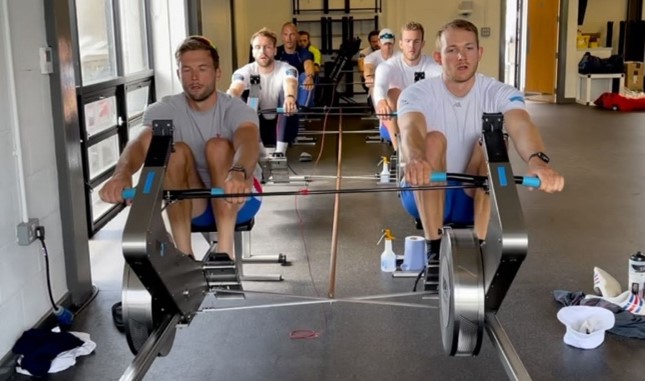
You can create scales for timing too. How fast does that feel, how slow? To one person, 0.2 seconds feels lightning-quick while to another it is plenty of time.
This is at least a start point for tuning expectations so that when the coach says ‘go’ there is an understanding of how hard to row and roughly how fast things are going to move.
Having time, taking time, making time
Thinking time. These scales show that we all need to calibrate our internal clocks together and the most common way to do this is to break down the whole stroke and learn the intricacies of the constituent parts. Once proficient they can be reinserted to the whole action. Before that, it can help just to have some good thinking going on, some concepts of what you are trying to do. One of these is to generate time: generate or create it, not ‘take’ it. You cannot take something that isn’t there, you have to earn it. So an honest, progressive acceleration from catch to finish means the boat will have plenty of speed under you as you begin the recovery. A boat which is dull and heavy in the drive will only leave one option in the recovery which is to rush forwards.
Relaxation: ‘If I have control of myself, I have control of time’ is a phrase I used previously and control comes through relaxation. Time slows down when your brain is calm and you think methodically. This is never more vital than when racing, because there is a lot going on at once. It all depends on our perception of time and whether a micro-moment is a tiny amount or, a comfortable one. So, try to practice rational thinking and conscious relaxation when working hard. Try to smile and enjoy the challenge of rowing fast together.
Specific ways to improve internal timing and feel
Blades, bodies, boat. These are the three areas where timing and feel need to match up and they obviously interact with each other. The process of getting this good internal timing is to start with the easy levels, rowing with light pressure and low rate, and progress upwards from there. It is interesting, however, that when you look at bio-mechanics power curves they can vary a lot between individuals at UT levels because in some ways there is too much time and not enough certainty about work levels.
Once you get to mid 20s rate and above half pressure, they tend to line up better so r.25-30 is a good range to get the timing sorted out. There is still time in the stroke cycle to focus on technique but also an honest amount of work. The boat feels more alive and gives better sensation of acceleration and run. Even physiological guides like heart rate tend to become more similar in this range. Furthermore you can also do quite a lot of training distance/time in this zone, for instance 4x 10’ at r.26, or 3x 20’ r.24, so you get perhaps 1,000 to 1,500 strokes to work it out.
Stretching the limits
I also like to test-play the technique just to see if the rowers’ brains are tuned in to their own bodies, each other, and the equipment. So with the Glover/Stanning W2-, for example, I would sometimes break up a long UT row by throwing in quick, impromptu commands like, “Five legs only then back to full,” or “Three at ¾ length then back to full,” or “one ½ slide pause, then continuous,” or “up two pips for a minute” – anything which kept them alert and searching for feel and one-ness. They enjoyed the challenges and playing with length, rate, and pressures kept developing their dexterity. To go straight and fast in a coxless pair you need to synchronise on length, power, depths, sequences, hands heights, boat rhythm, blade control and shape – basically everything!
The rower’s brain needs a little spare capacity to take in information
Testing technique like this is done to deliberately find and expose the limits, the point at which someone can no longer keep up, stay relaxed, focused, and remain in touch with the boat. Once you find the point where technique breaks down then you have done something useful in that session because you can then fix it. It might appear that this is purely physical skill but really it is about thinking; it is about getting comfortable with micro-moments, with the ability to control you power and your movements in all situations.
Above all, the rower’s brain needs a little spare capacity to take in information: if 100% of your mental capacity is soaked up with tension, and controlling just your own movements, then you cannot appreciate how to apply your power with others in a complementary way, nor in sympathy with the hull. In his book Bounce, Matthew Sayed talks about how the brain ‘chunks’ information, or ‘sees’ a movement pattern and all the components within but in a holistic way.
Cues and clues
Ways to keep tuned with each other include rowing eyes shut to build confidence that you can actually still feel balance and whereabouts you are on the slide. Even doing practice starts like this or racing bursts is possible as long as it is safe to do so.
Visual cues include watching the head, shoulders, or elbows of the person in front. Off the finish, the elbows are a key one because the legs and back should sit still for a moment and stay pressed, which imparts a sense of time and not haste, but the elbows can move away cleanly. The mass of the arms is not too significant so they can clear the finish easily, but the mass of the trunk is major so timing the rock over together is an important aspect of releasing the hull speed under the wheels. Quarter slide rowing at different pressures and rates is great for the ‘back end rhythm’.
Simulations and visualisations are also useful; on the ergo you can put the damper to zero and set up a TV with video of a favourite race, then ‘shadow row’ the race. This is handy to get a sense of how a top crew feels in terms of flow, cohesion, and dynamic movement. Whatever means you try, the important things is to discuss and compare with each other because internal timing is all about feel and perception and as such it is a personal thing with your own scale and interpretation attached to it.


